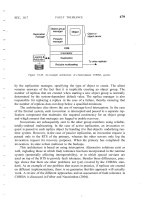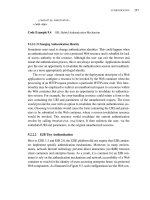iPhone OS Enterprise Deployment Guide Second Edition phần 8 doc
Bạn đang xem bản rút gọn của tài liệu. Xem và tải ngay bản đầy đủ của tài liệu tại đây (56.08 KB, 10 trang )
Appendix B Configuration Profile Format 71
Payload Content
The PayloadContent array is an array of dictionaries, where each dictionary describes an
individual payload of the profile. Each functional profile has at least one or more entries
in this array. Each dictionary in this array has a few common properties, regardless of
the payload type. Others are specialized and unique to each payload type.
PayloadIdentifier String, mandatory. This value is by convention a dot-delimited
string uniquely describing the profile, such as
“com.myCorp.iPhone.mailSettings” or
“edu.myCollege.students.vpn”. This is the string by which profiles
are differentiated—if a profile is installed which matches the
identifier of another profile, it overrides it (instead of being
added).
PayloadDisplayName String, mandatory. This value determines a very short string to
be displayed to the user describing the profile, such as “VPN
Settings”. It does not have to be unique.
PayloadDescription String, optional. This value determines what descriptive, free-
form text will be shown to the user on the Detail screen for the
entire profile. This string should clearly identify the profile so the
user can decide whether to install it.
PayloadContent Array, optional. This value is the actual content of the profile.
If it is omitted, the whole profile has no functional meaning.
PayloadRemovalDisallowed Boolean, optional. Default is No. If set, the user won’t be able to
delete the profile. A profile with this set can be updated via USB
or web/email only if the profile identifier matches and is signed
by the same authority. If a removal password is provided, the
profile can be deleted by specifying the password.
With signed and encrypted profiles, having this locking bit in
plain view is without consequence because the profile can’t be
altered and this setting is also shown on the device.
Key Value
Key Value
PayloadVersion Number, mandatory. The version of the individual payload.
Each profile can consist of payloads with different version numbers.
For instance, the VPN version number can be incremented at a
point in the future while the Mail version number would not.
PayloadUUID String, mandatory. This is usually a synthetically generated unique
identifier string. The exact content of this string is irrelevant;
however, it must be globally unique.
PayloadType String, mandatory. This key/value pair determines the type of the
individual payload within the profile.
PayloadOrganization String, optional. This value describes the issuing organization of the
profile, as it will be shown to the user. It can be, but doesn’t have to
be, the same as the root level PayloadOrganization.
72 Appendix B Configuration Profile Format
Profile Removal Password Payload
The Removal Password payload is designated by the
com.apple.profileRemovalPassword value of PayloadType. It’s purpose is to encode the
password that allows users to remove a configuration profile from the device. If this
payload is present, and has a password value set, the device will ask for the password
when the user taps a profile’s Remove button. This payload is encrypted with the rest of
the profile.
Passcode Policy Payload
The Passcode Policy payload is designated by the
com.apple.mobiledevice.passwordpolicy PayloadType value. The presence of this
payload type prompts device to present the user with an alphanumeric passcode entry
mechanism, which allows the entry of arbitrarily long and complex passcodes.
In addition to the settings common to all payloads, this payload defines the following:
PayloadIdentifier String, mandatory. This value is by convention a dot-delimited
string uniquely describing the payload. It’s usually the root
PayloadIdentifier with an appended subidentifier, describing the
particular payload.
PayloadDisplayName String, mandatory. This value is a very short string displayed to the
user which describes the profile, such as “VPN Settings”. It does not
have to be unique.
PayloadDescription String, optional. This value determines what descriptive, free-form
text is displayed on the Detail screen for this particular payload.
Key Value
Key Value
RemovalPassword String, optional. Specifies the removal password for the profile.
Key Value
allowSimple Boolean, optional. Default YES. Determines whether a simple
passcode is allowed. A simple passcode is defined as containing
repeated characters, or increasing/decreasing characters (such
as 123 or CBA). Setting this value to “NO” is synonymous to
setting minComplexChars to “1”.
forcePIN Boolean, optional. Default NO. Determines whether the user is
forced to set a PIN. Simply setting this value (and not others)
forces the user to enter a passcode, without imposing a length
or quality.
Appendix B Configuration Profile Format 73
Email Payload
The email payload is designated by the com.apple.mail.managed PayloadType value.
This payload creates an email account on the device. In addition to the settings
common to all payloads, this payload defines the following:
maxFailedAttempts Number, optional. Default 11. Allowed range [2 11]. Specifies the
number of allowed failed attempts to enter the passcode at the
device’s lock screen. Once this number is exceeded, the device is
locked and must be connected to its designated iTunes in order
to be unlocked.
maxInactivity Number, optional. Default Infinity. Specifies the number of
minutes for which the device can be idle (without being
unlocked by the user) before it’s locked by the system. Once this
limit is reached, the device is locked and the passcode must be
entered.
maxPINAgeInDays Number, optional. Default Infinity. Specifies the number of days
for which the passcode can remain unchanged. After this
number of days, the user is forced to change the passcode
before the device is unlocked.
minComplexChars Number, optional. Default 0. Specifies the minimum number of
complex characters that a passcode must contain. A “complex”
character is a character other than a number or a letter, such as
&%$#.
minLength Number, optional. Default 0. Specifies the minimum overall
length of the passcode. This parameter is independent of the
also optional minComplexChars argument.
requireAlphanumeric Boolean, optional. Default NO. Specifies whether the user must
enter alphabetic characters (“abcd”), or if numbers are sufficient.
pinHistory Number, optional. When the user changes the passcode, it has
to be unique within the last N entries in the history. Minimum
value is 1, maximum value is 50.
manualFetchingWhenRoaming Boolean, optional. If set, all push operations will be disabled
when roaming. The user has to manually fetch new data.
maxGracePeriod Number, optional. The maximum grace period, in minutes, to
unlock the phone without entering a passcode. Default is 0,
that is no grace period, which requires a passcode immediately.
Key Value
Key Value
EmailAccountDescription String, optional. A user-visible description of the email account,
shown in the Mail and Settings applications.
EmailAccountName String, optional. The full user name for the account. This is the
user name in sent messages, etc.
74 Appendix B Configuration Profile Format
EmailAccountType String, mandatory. Allowed values are EmailTypePOP and
EmailTypeIMAP. Defines the protocol to be used for that
account.
EmailAddress String, mandatory. Designates the full email address for the
account. If not present in the payload, the device prompts for
this string during profile installation.
IncomingMailServerAuthentication String, mandatory. Designates the authentication scheme for
incoming mail. Allowed values are EmailAuthPassword and
EmailAuthNone.
IncomingMailServerHostName String, mandatory. Designates the incoming mail server host
name (or IP address).
IncomingMailServerPortNumber Number, optional. Designates the incoming mail server port
number. If no port number is specified, the default port for a
given protocol is used.
IncomingMailServerUseSSL Boolean, optional. Default Yes. Designates whether the incoming
mail server uses SSL for authentication.
IncomingMailServerUsername String, mandatory. Designates the user name for the email
account, usually the same as the email address up to the @
character. If not present in the payload, and the account is set
up to require authentication for incoming email, the device will
prompt for this string during profile installation.
IncomingPassword String, optional. Password for the Incoming Mail Server. Use only
with encrypted profiles.
OutgoingPassword String, optional. Password for the Outgoing Mail Server. Use only
with encrypted profiles.
OutgoingPasswwordSameAsIncomi
ngPassword
Boolean, optional. If set, the user will be prompted for the
password only once and it will be used for both outgoing and
incoming mail.
OutgoingMailServerAuthentication String, mandatory. Designates the authentication scheme for
outgoing mail. Allowed values are EmailAuthPassword and
EmailAuthNone.
OutgoingMailServerHostName String, mandatory. Designates the outgoing mail server host
name (or IP address).
OutgoingMailServerPortNumber Number, optional. Designates the outgoing mail server port
number. If no port number is specified, ports 25, 587 and 465
are used, in this order.
OutgoingMailServerUseSSL Boolean, optional. Default Yes. Designates whether the outgoing
mail server uses SSL for authentication.
OutgoingMailServerUsername String, mandatory. Designates the user name for the email
account, usually the same as the email address up to the @
character. If not present in the payload, and the account is set
up to require authentication for outgoing email, the device
prompts for this string during profile installation.
Key Value
Appendix B Configuration Profile Format 75
Web Clip Payload
The Web Clip payload is designated by the com.apple.webClip.managed PayloadType
value. In addition to the settings common to all payloads, this payload defines the
following:
Restrictions Payload
The Restrictions payload is designated by the com.apple.applicationaccess PayloadType
value. In addition to the settings common to all payloads, this payload defines the
following:
Key Value
URL String, mandatory. The URL that the Web Clip should open when
clicked. The URL must begin with HTTP or HTTPS or it won’t work.
Label String, mandatory. The name of the Web Clip as displayed on the
Home screen.
Icon Data, optional. A PNG icon to be shown on the Home screen.
Should be 59 x 60 pixels in size. If not specified, a white square will
be shown.
IsRemovable Boolean, optional. If No, the user cannot remove the Web Clip,
but it will be removed if the profile is deleted.
Key Value
allowAppInstallation Boolean, optional. When false, the App Store is disabled and its
icon is removed from the Home screen. Users are unable to install
or update their applications.
allowCamera Boolean, optional. When false, the camera is completely disabled
and its icon is removed from the Home screen. Users are unable to
take photographs.
allowExplicitContent Boolean, optional. When false, explicit music or video content
purchased from the iTunes Store is hidden. Explicit content is
marked as such by content providers, such as record labels, when
sold through the iTunes Store.
allowScreenShot Boolean, optional. When false, users are unable to save a
screenshot of the display.
allowYouTube Boolean, optional. When false, the YouTube application is disabled
and its icon is removed from the Home screen.
allowiTunes Boolean, optional. When false, the iTunes Music Store is disabled
and its icon is removed from the Home screen. Users cannot
preview, purchase, or download content.
allowSafari Boolean, optional. When false, the Safari web browser application is
disabled and its icon removed from the Home screen. This also
prevents users from opening web clips.
76 Appendix B Configuration Profile Format
LDAP Payload
The LDAP payload is designated by the com.apple.ldap.account PayloadType value.
There’s a one-to-many relationship from LDAP Account to LDAPSearchSettings. Think of
LDAP as a tree. Each SearchSettings object represents a node in the tree to start the
search at, and what scope to search for (node, node+1 level of children, node + all
levels of children). In addition to the settings common to all payloads, this payload
defines the following:
CalDAV Payload
The CalDAV payload is designated by the com.apple.caldav.account PayloadType value.
In addition to the settings common to all payloads, this payload defines the following:
Key Value
LDAPAccountDescription String, optional. Description of the account.
LDAPAccountHostName String, mandatory. The host.
LDAPAccountUseSSL Boolean, mandatory. Whether or not to use SSL.
LDAPAccountUserName String, optional. The username.
LDAPAccountPassword String, optional. Use only with encrypted profiles.
LDAPSearchSettings Top level container object. Can have many of these for one
account. Should have at least one for the account to be useful.
LDAPSearchSettingDescription String, optional. Description of this search setting.
LDAPSearchSettingSearchBase String, required. Conceptually, the path to the node to start a
search at “ou=people,o=example corp”
LDAPSearchSettingScope String, required. Defines what recursion to use in the search.
Can be one of the following 3 values:
LDAPSearchSettingScopeBase: Just the immediate node pointed to
by SearchBase
LDAPSearchSettingScopeOneLevel: The node plus its immediate
children.
LDAPSearchSettingScopeSubtree: The node plus all children,
regardless of depth.
Key Value
CalDAVAccountDescription String, optional. Description of the account.
CalDAVHostName String, mandatory. The server address
CalDAVUsername String, mandatory. The user’s login name.
CalDAVPassword String, optional. The user’s password
CalDAVUseSSL Boolean, mandatory. Whether or not to use SSL.
CalDAVPort Number, optional. The port on which to connect to the server.
CalDAVPrincipalURL String, optional. The base URL to the user’s calendar.
Appendix B Configuration Profile Format 77
Calendar Subscription Payload
The CalSub payload is designated by the com.apple.subscribedcalendar.account
PayloadType value. In addition to the settings common to all payloads, this payload
defines the following:
SCEP Payload
The SCEP (Simple Certificate Enrollment Protocol) payload is designated by the
com.apple.encrypted-profile-service PayloadType value. In addition to the settings
common to all payloads, this payload defines the following:
Key Value
SubCalAccountDescription String, optional. Description of the account.
SubCalAccountHostName String, mandatory. The server address.
SubCalAccountUsername String, optional. The user’s login name
SubCalAccountPassword String, optional. The user’s password.
SubCalAccountUseSSL Boolean, mandatory. Whether or not to use SSL.
Key Value
URL String, mandatory.
Name String, optional. any string which is understood by the SCEP
server. For example, it could be a domain name like
example.org. If a certificate authority has multiple CA certificates
this field can be used to distinguish which is required.
Subject Array, optional. The representation of a X.500 name represented
as an array of OID and value. For example, /C=US/O=Apple Inc./
CN=foo/1.2.5.3=bar, which would translate to:
[ [ [“C”, “US”] ], [ [“O”, “Apple Inc.”] ], , [ [ “1.2.5.3”, “bar” ] ] ]
OIDs can be represented as dotted numbers, with shortcuts for
C, L, ST, O, OU, CN (country, locality, state, organization,
organizational unit, common name).
Challenge String, optional. A pre-shared secret.
Keysize Number, optional. The keysize in bits, either 1024 or 2048.
Key Type String, optional. Currently always “RSA”.
Key Usage Number, optional. A bitmask indicating the use of the key. 1 is
signing, 4 is encryption, 5 is both signing and encryption. Some
CAs, such as Windows CA, support only encryption or signing,
but not both at the same time.
78 Appendix B Configuration Profile Format
SubjectAltName Dictionary Keys
The SCEP payload can specify an optional SubjectAltName dictionary that provides
values required by the CA for issuing a certificate. You can specify a single string or an
array of strings for each key. The values you specify depend on the CA you’re using, but
might include DNS name, URL, or email values. For an example, see “Sample Phase 3
Server Response With SCEP Specifications” on page 85.
GetCACaps Dictionary Keys
If you add a dictionary with the key GetCACaps, the device uses the strings you provide
as the authoritative source of information about the capabilities of your CA. Otherwise,
the device queries the CA for GetCACaps and uses the answer it gets in response. If the
CA doesn’t respond, the device defaults to GET 3DES and SHA-1 requests.
APN Payload
The APN (Access Point Name) payload is designated by the com.apple.apn.managed
PayloadType value. In addition to the settings common to all payloads, this payload
defines the following:
Key Value
DefaultsData Dictionary, mandatory. This dictionary contains two key/value
pairs.
DefaultsDomainName String, mandatory. The only allowed value is
com.apple.managedCarrier.
apns Array, mandatory. This array contains an arbitrary number of
dictionaries, each describing an APN configuration, with the
key/value pairs below.
apn String, mandatory. This string specifies the Access Point Name.
username String, mandatory. This string specifies the user name for this
APN. If it’s missing, the device prompts for it during profile
installation.
password Data, optional. This data represents the password for the user for
this APN. For obfuscation purposes, it’s encoded. If it’s missing
from the payload, the device prompts for it during profile
installation.
proxy String, optional. The IP address or URL of the APN proxy.
proxyPort Number, optional. The port number of the APN proxy.
Appendix B Configuration Profile Format 79
Exchange Payload
The Exchange payload is designated by the com.apple.eas.account PayloadType value.
This payload creates a Microsoft Exchange account on the device. In addition to the
settings common to all payloads, this payload defines the following:
VPN Payload
The VPN payload is designated by the com.apple.vpn.managed PayloadType value.
In addition to the settings common to all payload types, the VPN payload defines the
following keys.
There are two possible dictionaries present at the top level, under the keys “PPP” and
“IPSec”. The keys inside these two dictionaries are described below, along with the
VPNType value under which the keys are used.
Key Value
EmailAddress String, mandatory. If not present in the payload, the device
prompts for this string during profile installation. Specifies the
full email address for the account.
Host String, mandatory. Specifies the Exchange server host name
(or IP address).
SSL Boolean, optional. Default YES. Specifies whether the Exchange
server uses SSL for authentication.
UserName String, mandatory. This string specifies the user name for this
Exchange account. If missing, the devices prompts for it during
profile installation.
Password String, optional. The password of the account. Use only with
encrypted profiles.
Certificate Optional. For accounts that allow authentication via certificate,
a .p12 identity certificate in NSData blob format.
CertificateName String, Optional. Specifies the name or description of the
certificate.
CertificatePassword Optional. The password necessary for the p12 identity certificate.
Use only with encrypted profiles.
Key Value
UserDefinedName String. Description of the VPN connection displayed on the
device.
OverridePrimary Boolean. Specifies whether to send all traffic through the VPN
interface. If true, all network traffic is sent over VPN.
VPNType String. Determines the settings available in the payload for this
type of VPN connection. It can have three possible
values: “L2TP”, “PPTP”, or “IPSec”, representing L2TP, PPTP and
Cisco IPSec respectively.
80 Appendix B Configuration Profile Format
PPP Dictionary Keys
The following elements are for VPN payloads of type PPP.
IPSec Dictionary Keys
The following elements are for VPN payloads of type IPSec.
Key Value
AuthName String. The VPN account user name. Used for L2TP and PPTP.
AuthPassword String, optional. Only visible if TokenCard is false. Used for L2TP
and PPTP.
TokenCard Boolean. Whether to use a token card such as an RSA SecurID
card for connecting. Used for L2TP.
CommRemoteAddress String. IP address or host name of VPN server. Used for L2TP and
PPTP.
AuthEAPPlugins Array. Only present if RSA SecurID is being used, in which case
it has one entry, a string with value “EAP-RSA”. Used for L2TP
and PPTP.
AuthProtocol Array. Only present if RSA SecurID is being used, in which case it
has one entry, a string with value “EAP”. Used for L2TP and PPTP.
CCPMPPE40Enabled Boolean. See discussion under CCPEnabled. Used for PPTP.
CCPMPPE128Enabled Boolean. See discussion under CCPEnabled. Used for PPTP.
CCPEnabled Boolean. Enables encryption on the connection. If this key and
CCPMPPE40Enabled are true, represents automatic encryption
level; if this key and CCPMPPE128Enabled are true, represents
maximum encryption level. If no encryption is used, then none
of the CCP keys are true. Used for PPTP.
Key Value
RemoteAddress String. IP address or host name of the VPN server. Used for Cisco
IPSec.
AuthenticationMethod String. Either “SharedSecret” or “Certificate”. Used for L2TP and
Cisco IPSec.
XAuthName String. User name for VPN account. Used for Cisco IPSec.
XAuthEnabled Integer. 1 if XAUTH is ON, 0 if it’s OFF. Used for Cisco IPSec.
LocalIdentifier String. Present only if AuthenticationMethod = SharedSecret.
The name of the group to use. If Hybrid Authentication is used,
the string must end with “[hybrid]”. Used for Cisco IPSec.
LocalIdentifierType String. Present only if AuthenticationMethod = SharedSecret.
The value is “KeyID”. Used for L2TP and Cisco IPSec.
SharedSecret Data. The shared secret for this VPN account. Only present if
AuthenticationMethod = SharedSecret. Used for L2TP and Cisco
IPSec.









